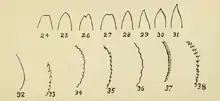< Page:British Flowering Plants.djvu
There was a problem when proofreading this page.
INTRODUCTION
7
to be observed in examining a plant. The shape of the base, tip, and margins have also to be considered.
| An image should appear at this position in the text. A high-res raw scan of the page is available. To use it as-is, as a placeholder, edit this page and replace "{{missing image}}" with "{{raw image|British Flowering Plants.djvu/21}}". If it needs to be edited first (e.g. cropped or rotated), you can do so by clicking on the image and following the guidance provided. [Show image]  |
The base may be cordate (fig. 19), sagittate (fig. 20), hastate (fig. 21), attenuated (fig. 22), or rounded (fig. 23).
The apex of the leaf may be truncated, as if broken off (fig. 24), rounded (fig. 25),incised(fig. 26), emarginate (fig. 27), obtuse (fig. 28), acute (fig. 29), spinose (fig. 30), or pointed (fig. 31).
The margin of the leaf is entire when it is not indented (fig. 32), serrated when it has small acute indentations and projections (fig. 33), crenated
This article is issued from Wikisource. The text is licensed under Creative Commons - Attribution - Sharealike. Additional terms may apply for the media files.